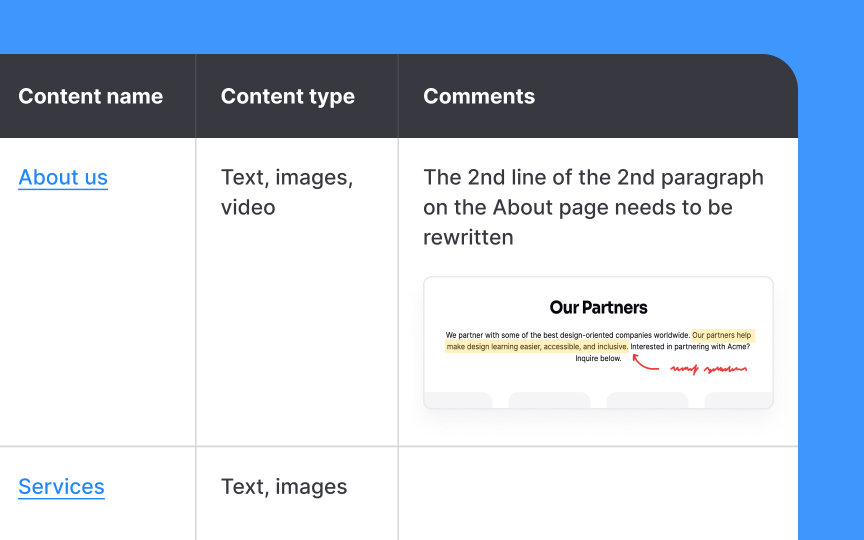Audit Planning and Setup
Create a solid foundation for effective design audits through systematic planning.
Think of design audit planning like preparing for an expedition. Just as explorers map their route, gather supplies, and assemble their team before venturing into unknown territory, thorough audit planning prevents teams from getting lost in the complexity of product evaluation.
The difference between a successful audit and a chaotic review often lies in preparation. It helps teams spot issues that might go unnoticed in day-to-day work and ensures that no critical areas slip through the cracks. From choosing the right tools to setting clear checkpoints, good planning transforms overwhelming product assessment into a clear path forward.
Clear objectives give direction to design audits. Like a compass pointing north, well-defined goals help teams stay focused on what matters most. They transform vague intentions like "improve the design" into specific, measurable targets.
Good audit objectives align with business goals while addressing specific design issues. They define what teams need to examine and what success looks like. Rather than broad goals like "improve consistency," effective objectives target specific areas: "identify component inconsistencies in the checkout flow and their impact on conversion." This clarity helps teams avoid scope creep and ensures findings drive meaningful improvements.
Setting measurable objectives also helps teams track progress and demonstrate value to stakeholders. When objectives connect design improvements to business metrics, they make the audit's impact clear and actionable.
Defining the right scope for a design audit helps focus evaluation efforts where they matter most. Like drawing boundaries on a map, proper scoping tells teams which design areas need attention and which can wait for later review.
Key scoping considerations include:
- Product coverage: Which products or features need design evaluation
- Design system elements: Which components and patterns to examine
- Platform scope: Which devices and platforms to include
- User flows: Which critical user journeys to assess
- Access needs: Required access to design files and documentation
Understanding these aspects helps teams conduct focused design audits that deliver actionable insights rather than overwhelming general reviews.
Every design audit needs clear criteria to be effective. Like a quality checklist for manufacturing, evaluation criteria create consistent standards for assessing design elements. They transform subjective opinions into measurable observations.
Key aspects include:
- Usability standards: Apply Nielsen's heuristics by creating specific questions for each principle. For example, turn "Error Prevention" into "Does the system prevent errors in critical user flows?"
- Accessibility guidelines: Break down WCAG requirements into testable criteria like contrast ratios, keyboard navigation, and screen reader compatibility
- Design system rules: Check how components follow defined styles, spacing, and behavior rules. Document deviations from standards
- Performance metrics: Define baseline metrics for load times, interaction speed, and animation smoothness
- User success metrics: Track completion rates, error occurrences, and time-on-task against set benchmarks
Well-defined criteria help teams focus on what matters most while ensuring different evaluators reach consistent conclusions.
Pro Tip: Base your criteria on actual user needs. Business preferences alone don't always reflect good design.
Proper tools streamline the design audit process and ensure consistent evaluation. Essential audit tools include:
- Documentation platforms: Figma, Notion, or Confluence for recording findings systematically
- Screen recording tools: Loom or ScreenStudio for capturing
interaction issues - Analytics tools: Hotjar or Google Analytics for understanding user behavior patterns
- Accessibility checkers: WAVE, Stark, or Axe for testing
WCAG compliance - Version control: Abstract or Figma version history to track design evolution
- Collaboration tools: Miro or FigJam for team analysis sessions
Selecting the right tools helps maintain audit quality while making the process more efficient and collaborative.
Effective
Essential documentation aspects include:
- Issue capture: Screenshots, annotations, and specific examples
- Context details: Where problems occur and who they affect
- Impact level: How severely each issue affects users
- Pattern tracking: Whether issues are isolated or systematic
- Evidence linking: Connection to user data or feedback
- Priority marking: Which issues need immediate attention
Proper documentation turns audit findings into clear action items while creating a reliable reference for future improvements.[1]
Clear roles and ownership make design audits more effective. Like a well-coordinated team sport, each member needs to understand their part in the evaluation process. This clarity helps prevent missed areas and duplicate efforts.
Key audit roles include:
- Lead auditor: Coordinates the process and ensures consistency
- Design evaluators: Examine specific interface areas
- Technical reviewers: Check implementation feasibility
- Stakeholder liaisons: Connect audit findings to business goals
- Documentation owners: Maintain organized audit records
Understanding who does what helps teams work efficiently and ensures all aspects of design get proper attention.[2]
Pro Tip: Create a RACI matrix for your audit team. It clarifies who needs to be Responsible, Accountable, Consulted, or Informed.
Planning the right timeline ensures thorough evaluation without disrupting regular work. Like planning a
Timeline considerations include:
- Initial assessment: Time to review current state and gather materials
- Core evaluation: Duration needed for thorough analysis
- Team availability: When key members can participate effectively
- Business cycles: Avoiding peak business periods
- Review periods: Time for validation and stakeholder feedback
- Documentation: Time to properly record and organize findings
Good timeline planning helps maintain audit quality while respecting team capacity and business needs.
Pro Tip: Add buffer time to your schedule. Audits often reveal issues that need deeper investigation.
Proper resource allocation ensures audits have what they need to succeed. Like budgeting for a project, understanding resource needs helps teams plan effectively and avoid bottlenecks.
Resource planning involves:
- Team time: Hours needed from each team member
- Tool access: Required software and platforms
- Documentation space: Where findings will be stored
- Meeting slots: When teams can review findings
- External help: Whether specialist expertise is needed
Understanding resource needs helps teams maintain regular work while conducting thorough audits.
Design audits need to consider potential risks to success. Like planning a safety inspection, understanding what might go wrong helps teams prepare and adapt their approach. This foresight prevents common pitfalls that could compromise audit quality.
Risk factors include:
- Time pressure: When tight deadlines affect thoroughness
- Access issues: Limited availability of design files or systems
- Team bias: Familiarity with existing designs affecting objectivity
- Scope creep: Unplanned expansion of audit areas
- Resource gaps: Missing expertise or tool access
Pro Tip: Review past audit challenges. They often reveal risks specific to your organization.
Clear communication with stakeholders ensures audit findings lead to actual improvements. Like presenting
Understanding different stakeholder needs helps shape how findings are presented. Product managers need to see business impact and resource requirements. Design leads focus on consistency and user experience improvements. Development teams care about technical feasibility and implementation clarity. Executive stakeholders want to understand strategic impact and return on investment.
This approach helps ensure recommendations get proper attention and support, turning insights into actual improvements.
Pro Tip: Link findings to business metrics. Stakeholders respond better to issues that affect measurable goals.
References
- What is a design audit and how do you conduct one? - Design strategy guide | Design strategy guide
- Roles and Responsibilities of Audit Participants | Quality Gurus | Quality Gurus
Top contributors
Topics
From Course
Share
Similar lessons

Introduction to Design Audits

Assumption Testing





















